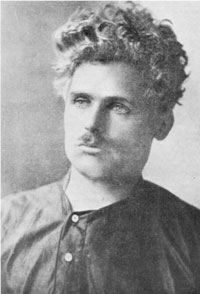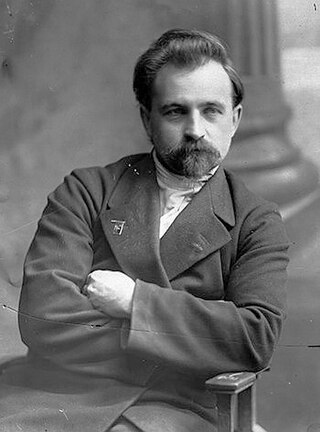Related Research Articles

Lev Davidovich Bronstein, better known as Leon Trotsky, was a Russian revolutionary, politician, and political theorist. He was a central figure in the 1905 Revolution, October Revolution, Russian Civil War, and establishment of the Soviet Union. Trotsky and Vladimir Lenin were widely considered the two most prominent Soviet figures, and Trotsky was de facto second-in-command during the early years of the Russian Soviet Republic. Ideologically a Marxist and Leninist, his thought and writings inspired a school of Marxism known as Trotskyism.

Leninism is a political ideology developed by Russian Marxist revolutionary Vladimir Lenin that proposes the establishment of the dictatorship of the proletariat led by a revolutionary vanguard party as the political prelude to the establishment of communism. Lenin's ideological contributions to the Marxist ideology relate to his theories on the party, imperialism, the state, and revolution. The function of the Leninist vanguard party is to provide the working classes with the political consciousness and revolutionary leadership necessary to depose capitalism.

The October Revolution, also known as the Great October Socialist Revolution, October coup, Bolshevik coup, or Bolshevik revolution, was a revolution in Russia led by the Bolshevik Party of Vladimir Lenin that was a key moment in the larger Russian Revolution of 1917–1923. It was the second revolutionary change of government in Russia in 1917. It took place through an armed insurrection in Petrograd on 7 November 1917 [O.S. 25 October]. It was the precipitating event of the Russian Civil War. The initial stage of the October Revolution which involved the assault on Petrograd occurred largely without any human casualties.

Trotskyism is the political ideology and branch of Marxism developed by Russian revolutionary and intellectual Leon Trotsky along with some other members of the Left Opposition and the Fourth International. Trotsky described himself as an orthodox Marxist, a revolutionary Marxist, and a Bolshevik–Leninist as well as a follower of Karl Marx, Frederick Engels, Vladimir Lenin, Karl Liebknecht, and Rosa Luxemburg. His relations with Lenin have been a source of intense historical debate. However, on balance, scholarly opinion among a range of prominent historians and political scientists such as E.H. Carr, Isaac Deutscher, Moshe Lewin, Ronald Suny, Richard B. Day and W. Bruce Lincoln was that Lenin’s desired “heir” would have been a collective responsibility in which Trotsky was placed in "an important role and within which Stalin would be dramatically demoted ".
The ten years 1917–1927 saw a radical transformation of the Russian Empire into a socialist state, the Soviet Union. Soviet Russia covers 1917–1922 and Soviet Union covers the years 1922 to 1991. After the Russian Civil War (1917–1923), the Bolsheviks took control. They were dedicated to a version of Marxism developed by Vladimir Lenin. It promised the workers would rise, destroy capitalism, and create a socialist society under the leadership of the Communist Party of the Soviet Union. The awkward problem, regarding Marxist revolutionary theory, was the small proletariat, in an overwhelmingly peasant society with limited industry and a very small middle class. Following the February Revolution in 1917 that deposed Nicholas II of Russia, a short-lived provisional government gave way to Bolsheviks in the October Revolution. The Bolshevik Party was renamed the Russian Communist Party (RCP).

The Communist International (Comintern), also known as the Third International, was an international organization founded in 1919 that advocated world communism, and which was led and controlled by the Communist Party of the Soviet Union. The Comintern resolved at its Second Congress in 1920 to "struggle by all available means, including armed force, for the overthrow of the international bourgeoisie and the creation of an international soviet republic as a transition stage to the complete abolition of the state". The Comintern was preceded by the dissolution of the Second International in 1916. Vladimir Lenin and Leon Trotsky were both honorary presidents of the Communist International.

Alexandra Mikhailovna Kollontai was a Russian revolutionary, politician, diplomat and Marxist theoretician. Serving as the People's Commissar for Welfare in Vladimir Lenin's government in 1917–1918, she was a highly prominent woman within the Bolshevik party. She was the first woman to be a cabinet minister, and the first woman ambassador.

The Workers' Opposition was a faction of the Russian Communist Party that emerged in 1920 as a response to the perceived over-bureaucratisation that was occurring in Soviet Russia. They advocated the transfer of national economic management to trade unions. The group was led by Alexander Shlyapnikov, Sergei Medvedev, Alexandra Kollontai and Yuri Lutovinov. It officially existed until March 1921 when it was forced to dissolve by the 10th Congress of the Russian Communist Party (Bolsheviks), and semi-clandestinely until the subsequent 11th Congress in 1922, where its main exponents teetered dangerously on the verge of being purged for fractionist activity. In some aspects, it was close with the German council communist movement, although there is no information about direct contacts between these groups.
The history of the Communist Party of the Soviet Union was generally perceived as covering that of the Bolshevik faction of the Russian Social Democratic Labour Party from which it evolved. In 1912, the party formally split, and the predecessor to the Communist Party of the Soviet Union became a distinct entity. Its history since then can roughly be divided into the following periods:
The United Opposition was a group formed in the All-Union Communist Party (Bolsheviks) in early 1926, when the Left Opposition led by Leon Trotsky, merged with the New Opposition led by Grigory Zinoviev and his close ally Lev Kamenev, in order to strengthen opposition against the Joseph Stalin-led Centre. The United Opposition demanded, among other things, greater freedom of expression within the Communist Party, the dismantling of the New Economic Policy (NEP), more development of heavy industry, and less bureaucracy. The group was effectively destroyed by Stalin's majority by the end of 1927, having had only limited success.

The 10th Congress of the Russian Communist Party (Bolsheviks) was held during March 8–16, 1921 in Moscow, Russia. The congress dealt with the issues of the party opposition, the New Economic Policy, and the Kronstadt rebellion, which started halfway through the Congress. The Congress was attended by 694 voting delegates and 296 non-voting delegates.
In Marxist theory, a new democratic society will arise through the organised actions of an international working class, enfranchising the entire population and freeing up humans to act without being bound by the labour market. There would be little, if any, need for a state, the goal of which was to enforce the alienation of labor; as such, the state would eventually wither away as its conditions of existence disappear. Karl Marx and Friedrich Engels stated in The Communist Manifesto and later works that "the first step in the revolution by the working class, is to raise the proletariat to the position of ruling class, to win the battle of democracy" and universal suffrage, being "one of the first and most important tasks of the militant proletariat". As Marx wrote in his Critique of the Gotha Program, "between capitalist and communist society there lies the period of the revolutionary transformation of the one into the other. Corresponding to this is also a political transition period in which the state can be nothing but the revolutionary dictatorship of the proletariat". He allowed for the possibility of peaceful transition in some countries with strong democratic institutional structures, but suggested that in other countries in which workers can not "attain their goal by peaceful means" the "lever of our revolution must be force", stating that the working people had the right to revolt if they were denied political expression. In response to the question "What will be the course of this revolution?" in Principles of Communism, Friedrich Engels wrote:
Above all, it will establish a democratic constitution, and through this, the direct or indirect dominance of the proletariat.
The 11th Congress of the Communist Party of the Soviet Union was held during 27 March – 2 April 1922 in Moscow. The congress was attended by 522 with a casting vote alongside 165 with consultative vote, and elected the 11th Central Committee.

Joseph Stalin started his career as a robber, gangster as well as an influential member and eventually the leader of the Bolshevik faction of the Russian Social Democratic Labour Party. He served as the General Secretary of the Central Committee of the Communist Party of the Soviet Union from April 3, 1922 until the official abolition of the office during the 19th Party Congress in October 1952 and supreme leader of the USSR from January 1924 until his death on March 5, 1953.

Timofei Vladimirovich Sapronov was a Russian revolutionary, Old Bolshevik and socialist militant who was one of the leaders of the Left Opposition in the Communist Party of the Soviet Union.

Yevgeni Alekseyevich Preobrazhensky was a Russian revolutionary, Soviet economist and sociologist. A member of the governing Central Committee of the Bolshevik faction and its successor, the All-Union Communist Party, Preobrazhensky is remembered as a leading voice for the rapid industrialisation of peasant Russia through a concentration on state-owned heavy industry.

The All-Russian Congress of Soviets evolved from 1917 to become the supreme governing body of the Russian Soviet Federative Socialist Republic from 1918 until 1936, effectively. The 1918 Constitution of the Russian SFSR mandated that Congress shall convene at least twice a year, with the duties of defining the principles of the Soviet Constitution and ratifying peace treaties. The October Revolution ousted the provisional government of 1917, making the Congress of Soviets the sole, and supreme governing body. This Congress was not the same as the Congress of Soviets of the Soviet Union which governed the whole Soviet Union after its creation in 1922.

The New Economic Policy (NEP) was an economic policy of the Soviet Union proposed by Vladimir Lenin in 1921 as a temporary expedient. Lenin characterized the NEP in 1922 as an economic system that would include "a free market and capitalism, both subject to state control", while socialized state enterprises would operate on "a profit basis".
Soviet democracy, also called council democracy, is a type of democracy in Marxism, in which the rule of a population is exercised by directly elected soviets. Soviets are directly responsible to their electors and bound by their instructions using a delegate model of representation. Such an imperative mandate is in contrast to a trustee model, in which elected delegates are exclusively responsible to their conscience. Delegates may accordingly be dismissed from their post at any time through recall elections. Soviet democracy forms the basis for the soviet republic system of government.
Proletarian internationalism, sometimes referred to as international socialism, is the perception of all proletarian revolutions as being part of a single global class struggle rather than separate localized events. It is based on the theory that capitalism is a world-system and therefore the working classes of all nations must act in concert if they are to replace it with communism.
References
- ↑ "On the Role and Tasks of Trade Unions [Abridged]". Soviet History Archive. 2002 [16 March 1921] – via marxists.org.
- ↑ "Tenth Congress of the Russian Communist Party (Bolshevik)". The Great Soviet Encyclopedia (3rd ed.). 1970–1979.
- ↑ Fitzpatrick, Sheila. The Russian Revolution. Oxford University Press, 1994. pp. 86–90.
- ↑ Kollontai, Alexandra. The Workers' Opposition. (1921). Marxists.org.
- ↑ Rigby, T. H. "Early Bolshevik Factionalism and Democratic Centralism," in The Bolsheviks: Party and Power 1917–1924. Macmillan Press, 1979.
- ↑ Cliff, Tony (1990). "Chapter 11: War Communism at an Impasse". Trotsky: The Sword of the Revolution 1917–1923. London: Bookmarks.
- ↑ Tony Cliff (1990). "Trotsky: The Sword of the Revolution 1917–1923". Bookmarks.
- ↑ Vladimir Lenin (1920). "The Trade Unions, the Present Situation and Trotsky's Mistakes". Marxists.org.
- ↑ Figes, Orlando. A People's Tragedy: The Russian Revolution 1891–1924. Pimlico, 1997. pp. 745–748.
- ↑ "On the Role and Tasks of Trade Unions [Abridged]". Soviet History Archive. 1921.
- ↑ Smith, S. A. Red Petrograd: Revolution in the Factories 1917–1918. Cambridge University Press, 1983.